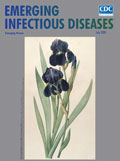
Volume 26, Number 7—July 2020
Letter
Enterovirus A71 Infection and Neurologic Disease, Madrid, Spain, 2016
To the Editor: Taravilla et al. (1) observed mucocutaneous manifestations of 6 children with enterovirus, and “the main manifestation was petechial rash on the extremities.” This finding is unusual for enterovirus A71 (EV-A71) infections. Cutaneous manifestations of EV-A71 are reported as vesicular skin lesions, not purpura (2). It is important that physicians distinguish between petechial and vesicular rashes because petechial rashes in children are linked to other infectious agents, including parvovirus B19 and (especially within the context of encephalitis) Neisseria meningitidis. A precise dermatologic description is necessary for a correct clinical diagnosis. A too-rapid clinical examination might result in confusion between vesicular rash and petechial rash, especially when vesicles are very small. To avoid confusion, the authors should have provided high-quality clinical photos of the rashes, skin biopsy results, or both before considering EV-A71 as a new cause of febrile petechial rash in children.
References
- Taravilla CN, Pérez-Sebastián I, Salido AG, Serrano CV, Extremera VC, Rodríguez AD, et al. Enterovirus A71 infection and neurologic disease, Madrid, Spain, 2016. Emerg Infect Dis. 2019;25:25–32.
- Hubiche T, Schuffenecker I, Boralevi F, Léauté-Labrèze C, Bornebusch L, Chiaverini C, et al.; Clinical Research Group of the French Society of Pediatric Dermatology Groupe de Recherche Clinique de la Société Française de Dermatologie Pédiatrique. Dermatological spectrum of hand, foot and mouth disease from classical to generalized exanthema. Pediatr Infect Dis J. 2014;33:e92–8.
Original Publication Date: June 08, 2020






















.png)











No hay comentarios:
Publicar un comentario